Carboxylic Acids and Derivatives - Acyl Groups (A-Level Chemistry)
Acyl Groups
Acyl Groups
Acyl groups are derived from carboxylic acids.
The structure of the acyl group is:
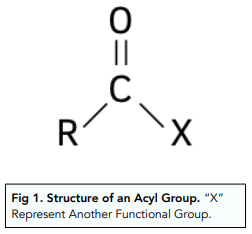
The diagram below shows the general structure of the different acyl groups you need to be familiar with.
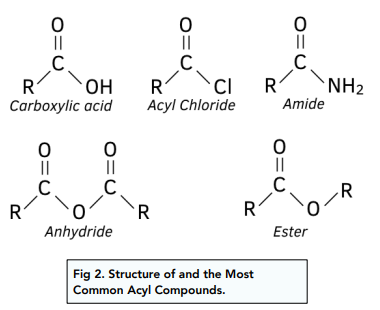
Acid anhydrides, acyl chlorides and amides are the acyl groups you will learn about in this chapter. Look carefully at their structures in the diagram.
Polarisation in Acyl Groups
To understand the reaction mechanism in acyl groups, we need to consider the forces at work within the acyl group.
The oxygen atom is more electronegative than the carbon atom it is attached to.
There are therefore permanent dipole-dipole forces in each acyl molecule.
The oxygen atom attracts the electron pair to itself more strongly, and becomes more negatively charged.
The C atom becomes more positively charged as shown in the diagram.
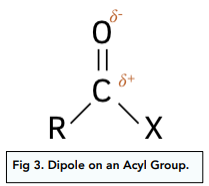
This causes the C????+ atom to be attacked by nucleophiles
The degree of polarisation, hence extent of nucleophilic attack, depends on the types of groups attached to the C atom in the acyl group.
Acyl Chlorides
The structural formula for an acyl chloride is R-COCl.
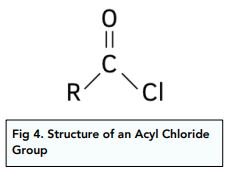
- A chloride group is attached to the C atom in the acyl group.
- The carbon atoms are numbered from the end with the acyl group.
- Acyl chlorides are named with the suffix -oyl chloride.
Worked example: Draw the structure of 3-bromobutanoyl chloride
Answer:
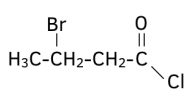
Polarisation in Acyl Chlorides
The chlorine attached to the “????⁺” C atom in the acyl chloride is also more electronegative than the carbon atom. Consider the molecule ethanoyl chloride.
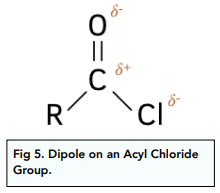
The electrons in the C-Cl bond are also withdrawn from the C towards the chlorine as well as the oxygen. This makes the “????⁺” C even more positively charged and very open to nucleophilic attack.
Acyl chlorides are very reactive as a result. Most of their reactions occur with cold reactants, are very vigorous, and highly exothermic.
This can make them dangerous reactants.
Acid Anhydrides
The structural formula for an acid anhydride is R-COOCOR’.
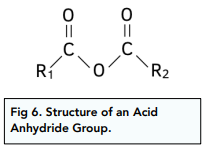
The C atom from the acyl group is attached to an ester group.
If the alkyl group on each C atom is the same, the acid anhydride is symmetrical.
Acid anhydrides are named with the ending -oic anhydride.
Worked example: Draw the skeletal structure of ethanoic anhydride.
Answer:

Polarisation in acid anhydrides
The ester group attached to the C is not as electronegative as the chloride group.
This makes acid anhydrides still quite reactive, due to the positive charge on the C atom, but not as violent as acyl chlorides.
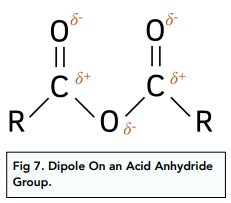
Reactions of Acyl Chlorides and Acid Anhydrides
Acyl chloride and acid anhydrides react in nucleophilic addition elimination reactions. The nucleophile attacks the C????+ as discussed in the previous section.
The reaction mechanism is the same for both acyl groups with the same reactants, however, the products formed are different.
The reactions with acyl chlorides occur at cold or room temperatures and are very vigorous/ violent. The reactions with acid anhydrides are less vigorous and may need gentle heating.
The table below summarises the key similarities and differences in the products formed. The reaction mechanisms are shown in full below.

Acyl Chlorides with Water
The overall nucleophilic addition elimination reaction mechanism is explained here in full, using the example of ethanoyl chloride and water.
1. Addition of the nucleophile. The lone pair of electrons on the oxygen atom in water acts as a nucleophile. They readily attack the C????+ atom in the acyl chloride and form a C-O bond. As this O atom now forms three bonds, it carries a fully positive charge.

2. Formation of the intermediate. The formation of the bond between C????+atom and the O from the water molecule, repels the electron pair from the C=O bond. The electron pair temporarily shifts to the O forming a lone pair. The O atom now has a fully negative charge. The intermediate is neutral overall.
3. Elimination of chlorine. The electron pair from the negative oxygen atom reforms the double bond with the C atom. The electron pair from the C-Cl bond is repelled and moves to the Cl atom; the C-Cl bond breaks.

4. Elimination of H from the nucleophile. An electron pair from the O-H bond moves to the positive O. The O-H bond breaks.

The products are ethanoic acid and hydrogen chloride.
Acyl Chlorides with Alcohols
The nucleophile is the lone pair of electrons on the oxygen atom in the alcohol.
Worked Example: Draw the reaction mechanism for the reaction of ethanol with ethanoyl chloride. Name the product made.
Answer: Ethyl ethanoate and hydrogen chloride are made

Phenols react much more slowly than alcohols. Therefore, when synthesizing an ester from a phenol, using an acyl chloride is preferred instead of using a carboxylic acid.

Acyl Chlorides with Ammonia
The nucleophile here is the lone pair of electrons is on the N atom in the ammonia molecule.
Worked Example: Draw the reaction mechanism for the reaction of ammonia with propanoyl chloride. Name the products made.
Answer: Ethanamide and ammonium chloride are made.


Acyl Chlorides with Primary Amines
The nucleophile in this reaction is the N atom from the amine group.
Worked Example: Draw the reaction mechanism for the reaction of ethylamine with propanoyl chloride. Name the products made.
Answer: N-ethyl propanamide and ethylammonium chloride are made.

Mechanism of Acid Anhydride with a Primary Amine
An example of a nucleophilic addition elimination reaction mechanism for the reaction between an acid anhydride and primary amine is shown here.
You can compare the mechanism with the acyl chloride and note the differences.

Making Aspirin
Aspirin is an ester made by reacting salicylic acid with ethanoic anhydride or with ethanoyl chloride.

In industry, ethanoic anhydride is preferred to ethanoyl chloride for the following reasons:
- It is cheaper
- It is less corrosive as a reactant
- The by-product formed with ethanoic anhydride is ethanoic acid and not very corrosive hydrogen chloride fumes
- The reaction is easier to control, as it is less reactive.
In chemistry, an acyl group is a functional group consisting of a carbonyl group (C=O) attached to an alkyl or aryl group. Acyl groups are derived from carboxylic acids and are found in various chemical compounds, including esters, amides, and anhydrides.
Some common examples of acyl groups include the methyl acyl group (CH3CO-), ethyl acyl group (C2H5CO-), and benzoyl group (C6H5CO-).
Acyl groups are important in organic chemistry because they can be used to form esters, amides, and anhydrides, which are important classes of organic compounds. Acyl groups can also be used as acylating agents to add acyl groups to other molecules.
In organic chemistry, an acylating agent is a molecule that donates an acyl group to another molecule, typically through a reaction called acylation. Acylating agents can be used to add acyl groups to various functional groups, such as alcohols, amines, and carboxylic acids.
Acyl groups are commonly used in the synthesis of drugs and other pharmaceuticals because they can be used to modify the properties of organic molecules, such as solubility and stability. Acylation reactions can be used to add functional groups to drug molecules, which can improve their efficacy and bioavailability.
Some common methods of acylation in organic chemistry include the Friedel-Crafts acylation reaction, which is used to add acyl groups to aromatic rings, and the acylation of alcohols and amines, which is used to form esters and amides, respectively. Other methods of acylation include the use of acyl halides and acid anhydrides as acylating agents.





Still got a question? Leave a comment
Leave a comment